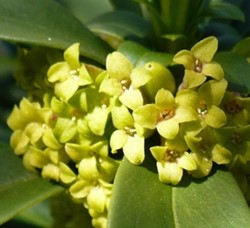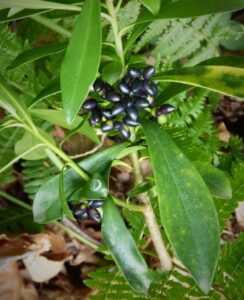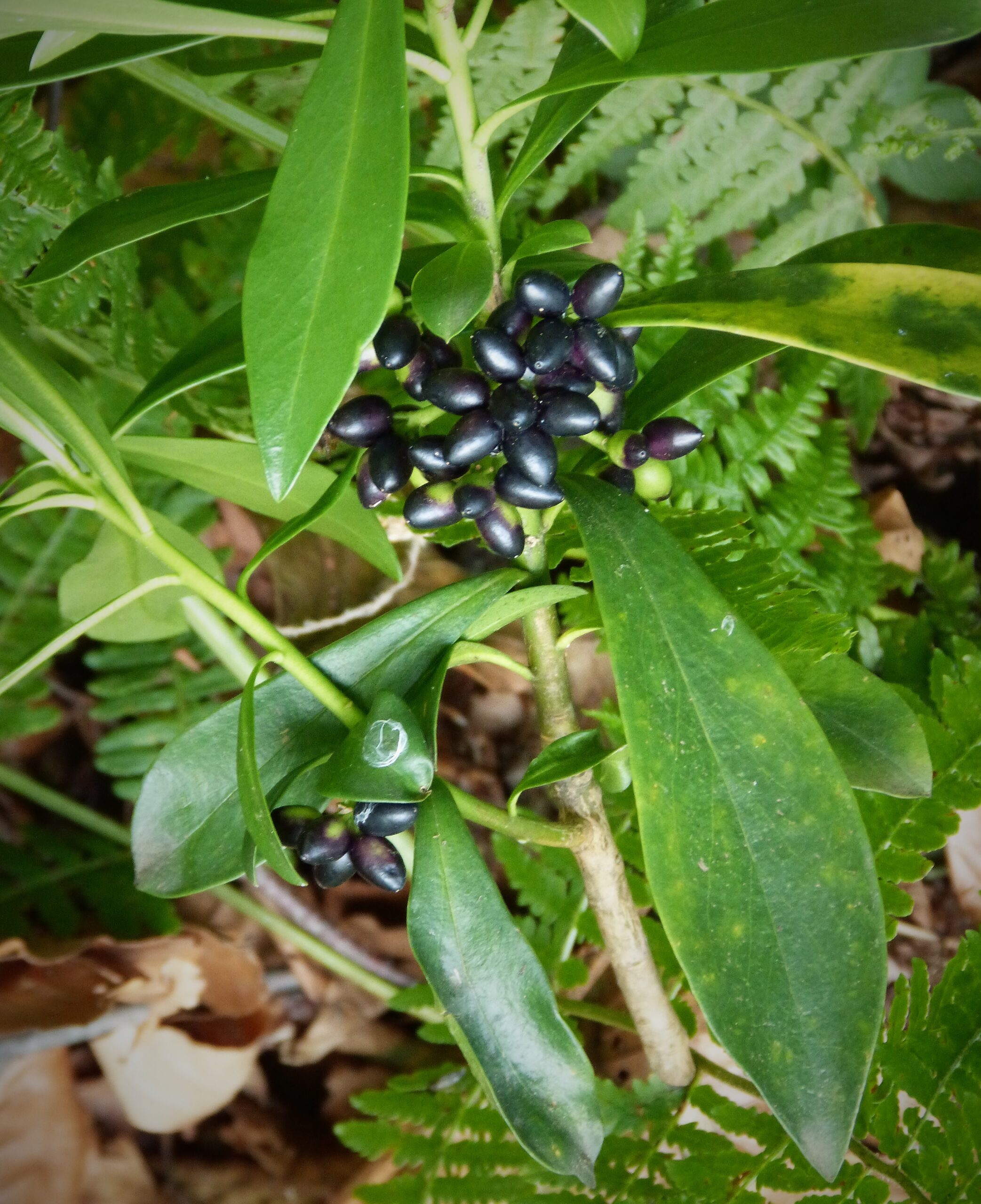
Mature plant
— San Juan County Noxious Weed Board
In conjunction with National Invasive Species Awareness Week (NISAW), Governor Jay Inslee proclaimed February 26 to March 3, 2024 as Washington Invasive Species Awareness Week to highlight and provide preventative solutions for invasive species. In honor of this program the Land Bank and San Juan County Noxious Weed Board are shining the spotlight on local bad actor Spurge Laurel.
A native to northern Africa and Europe, Spurge Laurel (Daphne laureola) has escaped garden settings and is rapidly naturalizing throughout San Juan County. It poses a particular threat to Garry oak woodlands and evergreen forests, outcompeting native understory species and disrupting native forest regeneration. All parts of the plant are toxic and can cause contact dermatitis, or if ingested, severe gastric distress. Several berries may be fatal if eaten by a child. Daphne is also poisonous to livestock, pets and other animals.
Spurge Laurel is a long-lived, shade-tolerant shrub, typically 2 to 4 feet tall. Its leathery, evergreen leaves (1 to 5 inches long) are alternately arranged in dense spirals near the branch tips. Blooming in late winter or early spring, small, yellow-green flowers appear at the base of the leaves. Mature seeds spread to new sites primarily via birds and rodents, or through land disturbing activities like earth-moving/land-clearing.

Flower close up
It may be confused with English or Portugal laurel, azaleas, Pieris and rhododendrons. Spurge Laurel differs from other Daphne species by its yellow-green flowers (not white, mauve or pink); berries (drupes) that are initially green, changing to black as they mature (not red); and, unlike other Daphnes, Spurge Laurel is prohibited for sale or trade in Washington State (WAC 16-752).
Control Methods
Caution: When working with Spurge Laurel, it is very important to wear protective clothing due to the plant’s irritating, caustic sap. Long-sleeved shirt, pants, gloves and protective eyewear are recommended. If exposed to its sap, wash affected areas with warm water and soap. Contact Poison Control at 1-800-222-1222 if accidental ingestion or serious illness occurs.
The simplest way to control spurge laurel is to pull or dig plants out by the roots, getting as much of the roots as practicable. Work in the moist season before the berries ripen to reduce spreading by seed. Small plants and seedlings are fairly easy to remove by hand in the fall and winter months. For larger shrubs, a weed wrench (available on loan) is a handy tool for extracting Spurge Laurel. Be sure to check your property once per year to locate new plants (seeds can remain viable for a few years).
If so inclined, an alternative method is to cut large shrubs to the ground with loppers or hand saw, immediately followed by application of a systemic herbicide to the freshly cut stumps (this helps prevent re-sprouting). If Spurge Laurel is simply cut but not painted, it is very likely to come back – worse than before! Please contact the San Juan County Noxious Weed Control Program for further guidance on this approach. Read and follow all product labels: it’s the law.

Mature fruit
Because of the damaging effects of Spurge Laurel’s sap to skin, eyes and respiratory tract, mowing is generally not recommended unless one takes great care to wear protective clothing. Oftentimes, cut plants will re-sprout, although shrub mortality may be higher with younger Spurge Laurel.
Disposal Methods
Now that you have successfully controlled Spurge Laurel, what do you do with the remains? First, DO NOT BURN Spurge Laurel due to its toxicity. Leave pulled plants on-site to decompose if they do not pose an immediate health threat to people, pets, or other animals. If you have the option of curbside pickup, bag with curbside garbage, or haul to the transfer station for free disposal. Never transport Spurge Laurel within a vehicle’s cabin due to its toxic, volatile sap.
If you need help identifying Spurge Laurel or need further information about other noxious weeds found in San Juan County, please contact the San Juan County Noxious Weed Control Program at 360-376-3499 or email at jasono@sanjuanco.com. Our website is extension.wsu.edu/sanjuan/noxious/
Thank you to Judy Jackson and Rich Lee for their past contributions to the content of this article.


